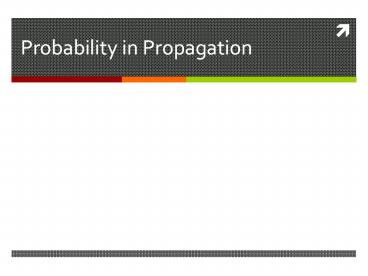Probability in Propagation - PowerPoint PPT Presentation
Title:
Probability in Propagation
Description:
Probability in Propagation ... A more extensive example A ... = 0.04 Note that the sum of these 4 options is 1 that means there is a 100% chance that one of these ... – PowerPoint PPT presentation
Number of Views:38
Avg rating:3.0/5.0
Title: Probability in Propagation
1
Probability in Propagation
2
Transmission Rates
- Models discussed so far assume a 100
transmission rate to susceptible individuals
(e.g. Firefighter problem) - Almost no diseases are this contagious
- Whooping cough 90 transmission rate
- HIV 2 transmission rate
3
Example
- Assume node A is infected.
- Let the transmission rate be p. In this example,
p0.8. - What is the chance that B is infected?
4
Example
- If B was infected by A, what is the chance that C
is infected by B? - What is the overall chance that C is infected?
5
Multiple Neighbors
- Both A and B are infected.
- What is the chance that C is infected in a
1-threshold model? - What about a 2-threshold model?
6
A closer look at the possibilities
Now let p0.6. Lets work out the possible
scenarios from the previous slide.
7
A more extensive example
- A and B start out infected. Let p0.6 as in the
previous slide. - What is the chance that C is infected in a
1-threshold model? - Let the probability that D is infected be 0.7.
What is the probability that E gets infected? - Repeat for a 2-threshold model.
8
All the possibilities!
9
When we need simulation
- A and B start infected. They can infect C and/or
D - If one node, say C, is uninfected, in the next
time step it could be infected by A or B again,
but it could also be infected by D. - If we change to an SIS or SIR or SIRS model, all
these calculations change. - The way the disease propagates at each time step
changes - Too much to calculate by hand, especially in big
nets!
10
Simulations
- Take a network. Set some nodes as I and others as
S. - When there is a probability, make a decision
(infect or not). Repeat for as long as the
simulation runs. Get results. - Repeat the simulation, making decisions that may
go the other way (e.g. a 60 transmission rate
may lead to infection in one simulation and no
infection in another) - Do the simulation a lot of times, and look at the
average result.































